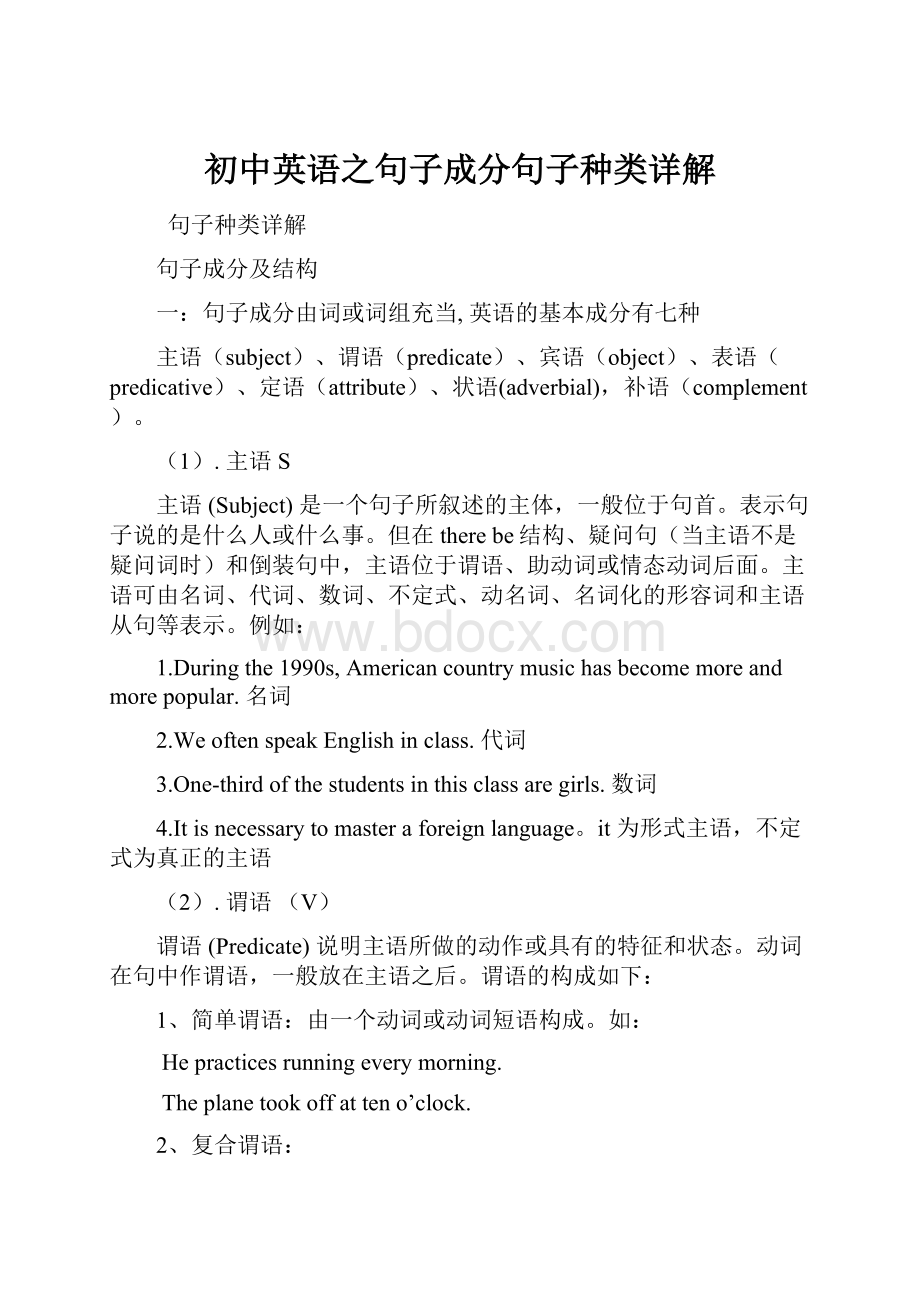初中英语之句子成分句子种类详解.docx
《初中英语之句子成分句子种类详解.docx》由会员分享,可在线阅读,更多相关《初中英语之句子成分句子种类详解.docx(17页珍藏版)》请在冰豆网上搜索。

初中英语之句子成分句子种类详解
句子种类详解
句子成分及结构
一:
句子成分由词或词组充当,英语的基本成分有七种
主语(subject)、谓语(predicate)、宾语(object)、表语(predicative)、定语(attribute)、状语(adverbial),补语(complement)。
(1).主语S
主语(Subject)是一个句子所叙述的主体,一般位于句首。
表示句子说的是什么人或什么事。
但在therebe结构、疑问句(当主语不是疑问词时)和倒装句中,主语位于谓语、助动词或情态动词后面。
主语可由名词、代词、数词、不定式、动名词、名词化的形容词和主语从句等表示。
例如:
1.Duringthe1990s,Americancountrymusichasbecomemoreandmorepopular.名词
2.WeoftenspeakEnglishinclass.代词
3.One-thirdofthestudentsinthisclassaregirls.数词
4.Itisnecessarytomasteraforeignlanguage。
it为形式主语,不定式为真正的主语
(2).谓语(V)
谓语(Predicate)说明主语所做的动作或具有的特征和状态。
动词在句中作谓语,一般放在主语之后。
谓语的构成如下:
1、简单谓语:
由一个动词或动词短语构成。
如:
Hepracticesrunningeverymorning.
Theplanetookoffatteno’clock.
2、复合谓语:
由情态动词或其他助动词加动词原形构成。
如:
Youmaykeepthebookfortwoweeks.
Hehascaughtabadcold.
注意:
谓语与主语在人称与数方面要保持一致。
(3)表语(P)
表语(Predicative)用以说明主语的性质、特征、状态与身份,它一般位于系动词之后。
表语一般由名词、代词、形容词、数词、副词、不定式、动名词、分词、介词短语及表语从句表示。
例如:
1.OurteacherofEnglishisanAmerican.(名词)
2.Isityours?
(代词)
3.Theweatherhasturnedcold.(形容词)
4.Thespeechisexciting.(分词)
5.Threetimessevenistwentyone?
(数词)
(4)宾语(O)
宾语(Object)表示动作的对象或承受者,一般位于及物动词和介词后面。
例如:
1.Theyvisitedanexhibitionyesterday.名词
2.Theheavyrainpreventedmefromcomingtoschoolontime.代词,动名词
3.Howmanydictionariesdoyouhave?
Ihavefive.名词,数词
宾语种类:
1)双宾语(间接宾语O+直接宾语O)
Lendmeyourdictionary,please.
Hegavemeabookyesterday.
2)复合宾语(宾语O+宾补C)
1.Theyelectedhimtheirmonitor.名词
2.Theypaintedtheirboatwhite.形容词
3.Letthefreshairin.介词
以上几种是句子的必要成分,不可缺少,否则句子意义就不完整。
句子除了必要成分外,还可以有定语,状语,同位语和插入语。
(5)定语
修饰,限制,描述或补充说明名词或代词的词、短语或从句称为定语(Attribute)。
1.Guilinisabeautifulcity.(形容词)
2.Chinaisadevelopingcountry;Americaisadevelopedcountry.(分词)
3.Therearethirtywomenteachersinourschool.(名词)
4.HisrapidprogressinEnglishmadeussurprised.(代词)
(6)状语
修饰动词、形容词、副词或整个句子,说明动作或状态特征的句子成分。
从情况,时间,处所,方式,条件,对象,肯定,否定,范围和程度等方面对谓语中心进行修饰或限制,状语一般由副词充当,也可由名词,介词短语,非谓语动词,从句等充当。
1.Lighttravelsmostquickly.副词及副词性短语
2.Hehaslivedinthecityfortenyears.介词短语
3.Waitaminute.名词
4.Onceyoubegin,youmustcontinue.状语从句
5.种状语种类如下:
1.Howaboutmeetingagainatsix?
时间
2.Lastnightshedidn’tgotothedancepartybecauseoftherain.原因
3.Ishallgothereifitdoesn’train.条件
4.MrSmithlivesonthethirdfloor.地点
5.Sheputtheeggsintothebasketwithgreatcare.方式
5.Shecameinwithadictionaryinherhand.伴随
6.Inordertocatchupwiththeothers,Imustworkharder.目的
7.Hewassotiredthathefellasleepimmediately.结果
8.Sheworksveryhardthoughsheisold.让步
9.Iamtallerthanheis.比较
(7)同位语(Appositive)对前面的名词或代词做进一步的解释,通常由名词、数词、代词或从句担任,如:
ThisisMr.Zhou,ourheadmaster.
Westudentsshouldstudyhard.
Weallarestudents.
(8)插入语(Parenthesis)对一句话做一些附加的解释,通常有tobehonest,Ithink(suppose,believe---)等,如:
Tobefrank,Idon’tquiteagreewithyou.
二:
英语句子的基本结构可以归纳成五种基本句型及其扩大、组合、省略或倒装。
掌握这五种基本句型,是掌握各种英语句子结构的基础。
基本句型一:
S│V(不及物动词)
1.Thesun│rose.
2.Who│cares?
此句型的句子有一个共同特点,即句子的谓语动词
都能表达完整的意思。
这类动词叫做不及物动词,
后面可以跟副词、介词短语、状语从句等。
基本句型二:
S│V(是系动词)│P(表语)
1.This│is│anEnglish-Chinesedictionary.
2.Thedinner│smells│good.
3.He│fell│inlove.
基本句型三:
SVO(主+谓+宾)
此句型句子的共同特点是:
谓语动词都具有实义,都是主语产生的动作,但不能表达完整的意思,必须跟有一个宾语,即动作的承受者,才能使意思完整。
这类动词叫做及物动词。
S│V(及物动词)│O(宾语)
1.Who│knows│theanswer?
2.He│hasrefused│tohelpthem.
基本句型四:
SVOO(主+谓+间宾+直宾)
有些及物动词可以有两个宾语。
这两个宾语通常一个指人(间接宾语);一个指物(直接宾语)。
S│V(及物)│O(多指人)│O(多指物)
1.She│ordered│herself│anewdress.
2.He│brought│you│adictionary.
基本句型五:
SVOC(主+谓+宾+宾补)
此句型的句子的共同特点是:
动词虽然是及物动词,但是只跟一个宾语还不能表达完整的意思,必须加上一个补充成分来补足宾语,才能使意思完整。
S│V(及物)│O(宾语)│C(宾补)
1.They│painted│thedoor│green.
2.This│set│them│thinking.
练习:
(一)选择句子结构
a,SVb,SVPc,SVO
d,SVoOe,SVOC
1.Pleasetellusastory._______
2.Shesmiled.______
3.Ihavealotworktodo._____
4.Hisjobistotrainswimmers._____
5.Henoticedamanentertheroom._____
6.Pleaselookatthepicture._____
(二).指出下列句子划线部分是什么句子成分:
v1.Thestudentsgotontheschoolbus.
v2.Hehandedmethenewspaper.
v3.Ishallansweryourquestionafterclass.
v4.WhatabeautifulChinesepainting!
v5.Theywenthuntingtogetherearlyinthemorning.
v6.Hisjobistotrainswimmers.
v7.HetookmanyphotosofthepalacesinBeijing.
v8.ThereisgoingtobeanAmericanfilmtonight.
v9.HeistoleaveforShanghaitomorrow.
v10.Hiswishistobecomeascientist.
v11.Hemanagedtofinishtheworkintime.
v12.Tomcametoaskmeforadvice.
v13.HefounditimportanttomasterEnglish.
v14.Doyouhaveanythingelsetosay?
v15.Tobehonest,yourpronunciationisnotsogood.
v16.Wouldyoupleasetellmeyouraddress?
v17.Hesatthere,readinganewspaper.
v18.Itisourdutytokeepourclassroomcleanandtidy.
v19.Henoticedamanentertheroom.
v20.Theapplestastedsweet.
句子种类
一、英语句子按用途可分为四类:
1、陈述句:
用来说明事实或说话人的看法,包括肯定句和否定句。
如:
He is a doctor.
I didn’t go to school yesterday.
2、祈使句:
用来表示请求、命令。
如:
Be quiet!
Don’t play with fire!
3、问句:
用来提出问题。
包括一般疑问句、特殊疑问句、选择疑问句、反意疑问句。
如:
Do you like English?
What time is it?
Does he like playing football or playing basketball?
They went out,didn’t they?
4、感叹句:
用来表达强烈的感情。
如:
What a fine day it is!
How beautiful!
二、用法讲析:
1、陈述句:
中考出题一般是将肯定句变为否定句。
几种常见形式:
(1)含有谓语动词be,变否定时,be后加not即be not……
I am a teacher→I am not a teacher.
There are some books→There are not any books.
(2)句子谓语动词是实义动词(如:
work live)时,要用助动词do/does/did+not+动词原形。
如:
They like swimming→They don’t like swimming.
Icame late→I didn’t come late
(3)句中含有all,both的句子,变完全否定时,要将all→none,both→neither,both…and…→neither…nor…要注意谓语动词的变化。
如:
All of us watched the TV→None of us watched theTV.
Bothofthemarestudents.→Neitherofthemis a student.
Both Tom and John have done the homework.→
Neither Tom nor John has done the homework.
(4)现在完成时、过去完成时态的句子变否定时变为have/has+not+done或had+not+done
(5)had better do something变否定时为had better not do…
如:
You’d better have a rest→You’d better not have a rest.
2、疑问句:
(1)一般疑问句:
一般指用Yes或No回答的疑问句。
I Tom at home?
Yes, he is./No, he isn’t.
Can you swim?
Yes,I can./No,I can’t.
Have they been to Beijing?
Yes,they have./No, they haven’t.
(2)特殊疑问句:
是以疑问词开头的疑问句。
常用疑问词what,where,who,how,what time,how long等其结构:
疑问词+一般疑问句?
要注意使用一般疑问句的语序。
.
My name is Mary→What is your name?
I usually get up at6:
30→When do you get up?
(3)选择疑问句:
提出两种或两种以上的情况,要求对方选择一种。
这种疑问句叫选择疑问句。
其结构:
“一般疑问句+or+其他?
”
Is her brother a doctor↗or a↘teacher?
前升后降
Shall we go to thecinema on↗Saturday or on↘Sunday?
注意:
回答时不用Yes或No,直接回答(根据事实回答)。
如:
—Does he like English or Chinese?
—He likes Chinese.
(4)反意疑问句:
反意疑问句又叫附加疑问句,是在陈述句之后,对陈述句所叙述的事实提出的疑问。
其基本结构有两种:
一是“肯定陈述句+简略否定问句”;
二是“否定陈述句+简略肯定问句”。
反意疑问句的前后两部分在时态、人称和数上都要保持一致。
如:
It looks like rain,doesn’t it?
He doesn't need to work so late,does he?
学习反意疑问句,特别要注意以下的一些特殊情况:
①陈述部分的主语是this,that时,疑问部分的主语多用it;陈述部分的主语是these,those时,疑问部分的主语是they。
如:
This is a dictionary,isn’t it?
Those are shelves,aren’t they?
②陈述句如果是there be结构时,疑问部分仍用there。
如:
There once was a man named Saint Nicholas,wasn’t there?
③陈述部分的谓语是had better(最好)时,疑问部分用hadn’t来体现。
如:
You’d better have a good rest,hadn’t you?
④陈述句的谓语动词是have(has)to(必须)时,疑问部分用助动词do或does来体现。
如:
They have to go there,don’t they?
He has to leave early,doesn’t he?
⑤陈述句的主语是动词不定式、动词的ing形式或从句时,疑问部分的主语多用it来体现。
如:
Taking care of our environment is very important,isn’tit?
What he said is right,isn’t it?
⑥陈述句中含有not、no、hardly、neither、never、few、little、too…to等否定词或是具有否定意义的词时,疑问部分常用肯定形式。
如:
Few people knew the news,did they?
Tom has never been to England,has he?
但陈述句中如果带有否定意义的前缀和后缀的单词时,整个句子仍视为肯定句,反意疑问部分多用否定形式。
如:
She is unhappy,isn’t she?
⑦陈述句中的谓语动词含有“推测”性的词must(一定)时,反意疑问部分多与must之后的动词形式和时态与句子主语保持一致。
Her mother must be a teacher,isn’t she?
She must have read the novel,hasn’t she?
⑧陈述句的主语是nobody,no one,everyone,somebody等不定代词时,反意疑问部分的主语多用they;如果陈述句的主语是something,nothing,anything,everything等不定代词时,反意疑问部分的主语多用it。
如:
Nobody says a word about the accident,do they?
Everything seems all right,doesn’t it?
⑨陈述句是主从复句时,如果主句的谓语动词是think、believe、expect、feel、guess等词,且主语是第一人称I时,反意疑问部分的人称、时态要与从句中的人称、时态保持一致,同时还要考虑到否定的转移。
如:
I believe that the boy can get a ticket for you,can’t he?
I don’t think he will come,will he?
⑩祈使句反意疑问句都可做成will you?
Please open the window,will you?
Don’t talk,will you?
但以Let’s开头的祈使句用shall we?
Let us……,will you?
Let me……,will you?
如:
Let’s go shopping,shall we?
Let us have a rest,will you?
注意:
对反意疑问句的回答,不管问题的提法如何,若事实是肯定的,就用yes,事实是否定的,就用no。
即Yes+肯定,No+否定。
这和汉语不一样,应特别注意。
如:
John hasn’t been to Beijing,has he?
Yes,he has.不,他去过。
No,he hasn’t.对,他没去过。
3、祈使句:
(1)祈使句是用来表示请求、命令、劝告或建议等语气的句子。
它的主语多是You(通常不说出)。
(2)祈使句可分为肯定、否定两种形式。
其中肯定形式的祈使句由动词原形开头,分两类:
① 连系动词+表语(如:
形容词、名词等)引起。
例如:
Keep quiet!
保持安静!
② 行为动词开头。
例如:
Open the door!
打开门吧!
否定形式的构成是一律在肯定形式的祈使句之前加上Don’t。
例如:
Don’t go there alone!
不要一个人去那里。
Don’t be late for class again!
别再上课迟到
(3)在祈使句中加上please可构成“Please…”或“…,please.”句式,please使句子语气显得更委婉、礼貌。
此时的否定句应变为“Please don’t……”或“Don’t……,please.”
(4)由let构成的肯定式的祈使句句型为:
(5)祈使句的主语通常不说出来,但有时为了指明向谁提出请求、命令等时,或为了加强语气,此时可说出主语you。
例如:
You feed the animals today.今天你喂动物。
You sweep the floor.你拖地板。
4、感叹句:
〈一〉种类:
感叹句通常由what或how引导,一般各有三种情况:
(1)What引导的感叹句
① What+a(an)+形容词+可数名词的单数形式+主语+谓语!
如:
Whata new watch it is!
多么新的一块手表啊!
②What+形容词+可数名词的复数形式+主语+谓语!
如:
What interesting books the children are reading!
孩子们读的书多么有趣啊!
③What+形容词+不可数名词+主语+谓语!
如:
What important news it is!
多重要的新闻啊!
(2)How引导的感叹句
① How+形容词或副词+主语+谓语!
如:
How tall the girl is!
那个女孩多高啊!
② How+主语+谓语!
如:
How time flies!
间过得多快!
〈三〉
另外主语+be+adj+to do……变感叹句:
How+adj+主语+be+to do……
如:
I am very happy to hear the good news.→
How happy